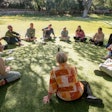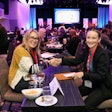
The day after overseeing Bend the Arc’s almost-glitch free virtual two-day conference in May, Adina Alpert’s computer wonks out on a Zoom call with a reporter. Better at that moment than during the Jewish organization’s Pursuing Justice 2020, a two-day event adapted as COVID-19 changed the global discussion and has forced conferences that don’t postpone to go virtual.
Held every four years, not coincidentally to coincide with the U.S. presidential elections, the conference sheds light on inequality throughout society. Its speakers include political leaders like U.S. Sen. Dick Durbin (D-Ill.) and well-known activists like author and civil rights activist Eric Ward, #BlackLivesMatter co-creator Alicia Garza and Color of Change President Rashad Robinson.
About 500 people—half of Bend the Arc’s goal–were registered to attend the faith-based event at Marriott Wardman Park Hotel in Washington D.C., before the coronavirus changed everything for everyone in mid-March.
Alpert, Bend the Arc’s national conference manager, estimates 1,300 joined the Zoom-based event May 3-4. She recalls a comment made during an after-hours “party” on the first night remarking how smoothly things were running. And sure enough, hours of online content—a mix of recorded and lived—aired uninterrupted until a tiny blip happened with about 10 minutes left in the closing remarks.
“It made it feel like a real event—there are always mic problems,” says Alpert, who says Pursuing Justice was the biggest event she ever planned and her first virtual conference, too.
“But honestly, I was pleasantly surprised how all of our planning paid off. There were so many moving pieces and we were making our best guesses. I think we did really well.”
Connect Faith goes behind-the-scenes of Pursuing Justice with Alpert.
Why go virtual instead of postponing the conference?
I’ll credit our CEO (Stosh Cotler) with this. She made it really clear that we didn’t know when [the coronavirus crisis] was going to end and we didn’t know what it was going to look like on the other side. I don’t know when there is going to be a feeling of being back to normal. We didn’t know if we could put money on the line when we didn’t know what the future would be. We knew there was a way to do something meaningful virtually. So, when we decided to cancel the in-person component, in the same breath decided to be virtual in some way.
Take us through the steps of adapting from an in-person event to a virtual one?
In our celebration, one staff member said that we took it slow so we can go fast and I think that’s right. In those first five weeks we were weighing options, and we were moving a bit slowly as we were taking in the world and adjusting to working from home—some of the staff with little ones at home or full-time jobs. We didn’t rush decisions. We gave ourselves the chance to think about different implications. But when we made our plan, we hit the ground running and the last few weeks were full of prep.
Did you immediately decide to use Zoom for the conference?
We did evaluate some other platforms, but from the beginning, Zoom felt right for the workshops given how the breakouts work, it’s user-friendly and how many people are already learning to use it. We didn’t want people learning a whole new platform. There was a question with the general sessions where we would be broadcasting, but we wanted a consistent platform where people can chat.
Were you worried the conference’s content would remain relevant at a time when COVID-19 dominates the discussion?
Definitely. When we did look through all our workshops, they all were relevant regardless of the moment. We did add additional content like a workshop connecting social justice with COVID-19. The general sessions did change a great deal. We were well on our way to planning four of them and those looked quite different. The panel about resilience and taking care of yourself was definitely thought of in this moment.
We had most of the second-session speakers confirmed and we invited them to pivot with us. They were always going to reflect on the future, but obviously in such a different way in this moment. They all were able to speak to that in a powerful way.
What do you make of seeing these famous keynote speakers speaking from their homes?
There has been a lot of texting and comments that have been funny like “look at their book selection.” I think it adds a level of intimacy that I am really loving. It is taking someone from being perhaps harder to access or being so different from us, and then we see them in their homes, it’s like “OK, great we can do this together. I can be on your team.”
What are some lessons planners can take from holding events in this crisis?
I’m hoping when we go back to in-person gatherings, God willing, we take some lessons about accessibility and how in-person gatherings are inaccessible to many people. There’s the cost and travel barrier. We heard from so many people they weren’t going to be able to join in D.C. but were happy to join us online. When we gather for retreats, maybe we can have an option for a virtual attendee who pays a different rate and can join on a special link to the livestream. Maybe there are workshops that are only offered virtually. We’re making lemons out of lemonade now, but people in social justice with accessibility issues have been asking to adjust this way for a long time and we have to hear them.
We’re also seeing really interesting stuff happening, from teachers especially, about asynchronous learning and making things available that people can access it their own time. I'm excited that we're doing that after the conference. I think folks will play around with what needs to be live or not and what can be recorded. Hopefully, they'll continue to experiment with modalities of audio, video and maybe written. I’m just thinking of hard it is for people to be online so much and help them access the content.



















